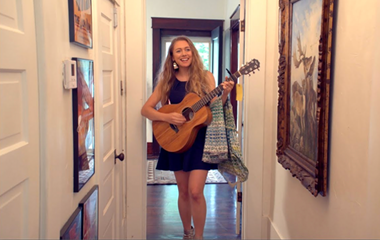You can’t hang around estate sales for very long without eventually running into a piece of Pyrex; for example, a vintage Gooseberry 473 (if you want to get technical). While estate sales aren’t the only places to find vintage Pyrex, they’re a pretty good way to start your search, especially as the Baby Boomers begin to let go of their collections. You can often find better deals at an estate sale than you’ll find online.

Why Vintage Pyrex?
Why not? Part of Pyrex’s popularity is due to the nostalgia factor. Many collectors love Pyrex simply because it reminds them of childhood. Pyrex lover Sylvia Schanche says she inherited pieces from her mother and grandmother and likes using pieces she remembers as a kid growing up in the 60s and 70s. Her vintage Pyrex collection is spread out all over her house because she incorporates her pieces into daily use (known to insiders as “Pyrex in action”).
On the other end of the Pyrex-collecting spectrum is a young, twenty-something Pyrex enthusiast who calls herself PyrexHellcat. PyrexHellcat says she got into the hobby by way of the whole 1950s-muscle car-pinup scene. Her Pyrex collection is just for show, and she changes her displays with the seasons. For her, Pyrex is a way of expressing her unique style.
For still others, the fun of Pyrex is in the thrill of the hunt. (Vintage Jadeite and Fire King have similar followings). Pyrex aficionado Ashley Jennette said she felt a special thrill whenever she walked into a thrift shop and saw a piece of Pyrex “in the wild.”

One thing’s certain: whether you’ve been collecting Pyrex for years or are new to the game, you’ll find that (like anything midcentury modern), the demand outweighs the supply. This sudden surge in popularity makes some Pyrex collectors wary. They don’t want demand driving the value of Pyrex up. (Collectors, whether they’re into Pyrex or Star Wars collectibles, are a lot like hipsters: territorial over their “thing,” whatever it is, and always in search of that next cool piece to add to their collection. . . the more obscure the better).
But don’t let the rabid Pyrex junkies scare you off from this throwback hobby. Pyrex hunting and collecting is fun and easy, if you know what to look out for. But first – the facts.
What Is Pyrex?
Pyrex was originally made out of borosilicate glass, which was created to use in science labs because it didn’t expand or contract with heat. In 1915, the glass was sold to Corning Glassware and branded under the new name “Pyrex” which was then used to create all sorts of kitchenware. It’s been popular ever since, even after the 1998 switch from borosilicate to the cheaper and even more thermal resistant tempered glass.
When the clear-glass ovenware debuted in 1915, it was considered a boon to kitchens everywhere because now chefs (and housewives) could keep an eye on their food while it was cooking. By 1922, the Pyrex line featured 22 different pieces that served various purposes.

Pyrex Colors
But the colored vintage Pyrex bowls, which debuted in 1947 and lasted well into the 1980s are what collectors go crazy over. These are the sets comprised of colored and opal dishes featuring silkscreened decorative patterns that your grandmother might have used, and they come in various vessels: casserole dishes, space savers, chip ‘n dip sets, nesting mixing bowls, refrigerator sets that include square-shaped stackable containers called “fridgies,” and more. And don’t forget the famous Cinderella bowls, which feature a spout on either side for easier pouring. Patterned Pyrex also came in other kitchen “compatibles,” like butter dishes, carafes, coffee and tea cups, and even dishes.

Pyrex Patterns
While everyone has their favorite Pyrex pattern, the rarer patterns are in higher demand for obvious reasons. Pyrex patterns are classified as Standard or Promotional. Standard patterns were manufactured for at least two years, while promo patterns were only featured on a limited number of pieces for a limited time. As you can imagine, promotional Pyrex patterns can be quite expensive. In fact, the Pyrex pattern that’s the most in demand can go for upwards of $4,000 and is called Lucky in Love. If you ever find one of these pieces, you’ll be lucky indeed.
But even if you don’t find Lucky in Love, you can still luck out with several other Pyrex patterns at estate sales, Etsy, online, and more. Scroll through our Pyrex Pattern Timeline to find your favorite.
*Promotional Pyrex patterns are marked with an asterisk.
1915 Antique Pyrex

1945 Primary Colors

1956 Pink Daisy

1956 Snowflake

1957 Butterprint

1958 Gooseberry

1958 Balloons*

1958 Golden Hearts*

1958 Rooster Black*

1958 Musical Staff*

1962 Early American

1963 Town & Country

1964 Ivy*

1964 Terra (Blue)

1967 Saxony*

1968 Daisy

1969 Hearts Scroll/“Celtic Floral”*

1971 Friendship

1972 Snowflake Blue

1972 Butterfly Gold

1972 Spring Blossom Green

1978 Woodland

1980 Autumn Harvest

1983 Colonial Mist

A huge sincere thank-you to all our Facebook & Instagram fans who contributed photos from their lovely Pyrex collections!
References:

Do you have any photos of vintage Pyrex to add to the timeline? Post them in the comments below!



